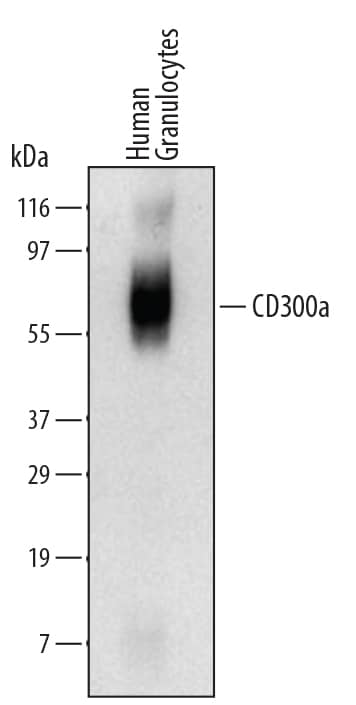Human CD300a/LMIR1 Antibody
R&D Systems, part of Bio-Techne | Catalog # MAB2640


Conjugate
Catalog #
Key Product Details
Species Reactivity
Human
Applications
CyTOF-ready, Flow Cytometry, Western Blot
Label
Unconjugated
Antibody Source
Monoclonal Rat IgG2A Clone # 232612
Product Specifications
Immunogen
Y3 rat myeloid cell line transfected with human CD300a/LMIR1
Specificity
Detects human CD300a/LMIR1 in direct ELISAs and Western blots. In direct ELISAs and Western blots, 100% cross‑reactivity with recombinant human LMIR2 (CMRF-35A) is observed and no cross-reactivity with recombinant human LMIR3, 4, 5, or 6 is observed.
Clonality
Monoclonal
Host
Rat
Isotype
IgG2A
Scientific Data Images for Human CD300a/LMIR1 Antibody
Detection of Human CD300a/LMIR1 by Western Blot.
Western blot shows lysates of human granulocytes. PVDF membrane was probed with 2 µg/mL of Rat Anti-Human CD300a/LMIR1 Monoclonal Antibody (Catalog # MAB2640) followed by HRP-conjugated Anti-Rat IgG Secondary Antibody (HAF005). A specific band was detected for CD300a/LMIR1 at approximately 60 kDa (as indicated). This experiment was conducted under non-reducing conditions and using Immunoblot Buffer Group 1.Applications for Human CD300a/LMIR1 Antibody
Application
Recommended Usage
CyTOF-ready
Ready to be labeled using established conjugation methods. No BSA or other carrier proteins that could interfere with conjugation.
Flow Cytometry
2.5 µg/106 cells
Sample: Human whole blood
Sample: Human whole blood
Western Blot
Human granulocytes under non-reducing conditions only
Formulation, Preparation, and Storage
Purification
Protein A or G purified from hybridoma culture supernatant
Reconstitution
Reconstitute at 0.5 mg/mL in sterile PBS. For liquid material, refer to CoA for concentration.
Formulation
Lyophilized from a 0.2 μm filtered solution in PBS with Trehalose. *Small pack size (SP) is supplied either lyophilized or as a 0.2 µm filtered solution in PBS.
Shipping
Lyophilized product is shipped at ambient temperature. Liquid small pack size (-SP) is shipped with polar packs. Upon receipt, store immediately at the temperature recommended below.
Stability & Storage
Use a manual defrost freezer and avoid repeated freeze-thaw cycles.
- 12 months from date of receipt, -20 to -70 °C as supplied.
- 1 month, 2 to 8 °C under sterile conditions after reconstitution.
- 6 months, -20 to -70 °C under sterile conditions after reconstitution.
Background: CD300a/LMIR1
References
- Clark, G.J. et al. (2009) Trends Immunol. 30:209.
- Cantoni, C. et al. (1999) Eur. J. Immunol. 29:3148.
- Munitz, A. et al. (2006) Blood 107:1996.
- Bachelet, I. et al. (2005) J. Immunol. 175:7989.
- Alvarez, Y. et al. (2008) Mol. Immunol. 45:253.
- Ju, X. et al. (2008) Blood 112:1184.
- Clark, G.J. et al. (2007) J. Leukoc. Biol. 82:1126.
- Kumagai, H. et al. (2003) Biochem. Biophys. Res. Commun. 307:719.
- Yotsumoto, K. et al. (2003) J. Exp. Med. 198:223.
- Bachelet, I. et al. (2008) J. Immunol. 180:6064.
- Bachelet, I. et al. (2006) J. Allergy Clin. Immunol. 117:1314.
- Munitz, A. et al. (2006) J. Allergy Clin. Immunol. 118:1082.
Alternate Names
CD300a, CLM8, CMRF-35H, IGSF12, IRC1, IRC2, IRp60, LMIR1, MAIR-I, Mcipr1, NKRL, Pigr4
Gene Symbol
CD300A
Additional CD300a/LMIR1 Products
Product Documents for Human CD300a/LMIR1 Antibody
Product Specific Notices for Human CD300a/LMIR1 Antibody
For research use only
